Once again, Blake Road Productions does a wonderful job capturing our recent showcase concert at Shalin Liu Performance Center in Rockport, MA. This is just the highlight reel; full concert segments are available on the Mass Cultural Council YouTube channel.
Category: Uncategorized
Traditional Arts Apprenticeship Opportunity
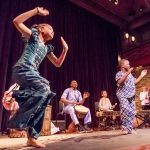


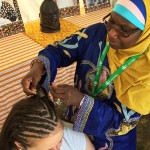
Apprenticeships are a time-honored method by which an individual learns skills, techniques, and artistry under the guidance of a recognized master. Since its founding in 2001, the Massachusetts Cultural Council’s Traditional Arts Apprenticeship Program has funded over 100 artists in a vast array of traditions, both old and new to Massachusetts. Applications are now available.
Recent apprenticeships funded by Mass Cultural Council’s Folk Arts and Heritage Program include mentorships in Cape Breton step dancing, design and building of wooden ship’s steering wheels, Cambodian traditional ornamentation, wooden boatbuilding and restoration, West African dance, Scottish & Cape Breton fiddling, and Mithila and Warli arts.
The deadline for applying is April 12, 2018. Guidelines and applications are now available.
2018 Fellows & Finalists in the Traditional Arts Awarded by Mass Cultural Council
We are delighted to announce the 2018 Artist Fellows and Finalists in the Traditional Arts, awarded by Mass Cultural Council. Fellows each receive $12,000 and Finalists each receive $1,000. The next opportunity to apply for these awards will be October of 2019.
ARTIST FELLOWS:
Kieran Jordan, Traditional Irish step dance

At the age of five, Kieran Jordan watched Irish step dancing for the first time in a St. Patrick’s Day parade. Soon after, she was taking lessons in her parish hall on Saturday mornings. Thus began her life-long journey to becoming not only a renowned Irish step dancer, but also a cultural activist and an invaluable resource within the Irish-American community.
Jordan is a gifted dancer, choreographer, and teacher of old style Irish step dances, a tradition that is intricately tied to Irish history, local culture, and traditional music. She displays the aesthetic assurance that naturally evolves from the dedication of a gifted artist who has danced competitively within the Irish traditional step-dancing sphere.
Panayotis League, Greek lauto playing and oral poetry
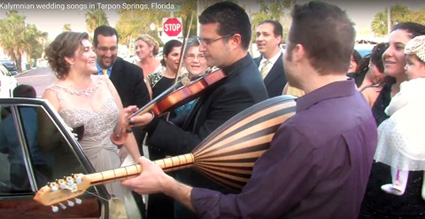
Panayotis League specializes in traditional Greek music and oral poetry indigenous to the Greek island of Kalymnos, Crete, and their diaspora communities. With family roots in the Greek community of Tarpon Springs, Fla, League pursued his interest in traditional music by journeying to the Greek islands to study laouto and tsabouna, with older master musicians on Kalymnos in 2001 and violin on Crete in 2003.
Today League is one of the few in the US who specializes in the laouto music of Kalymnos. In addition to concerts and festivals, he is a frequent performer at local marriage celebrations, baptisms, and feast days in the Greek diaspora community. He is also a scholar of Greek music. His dissertation focused on the music of Boston’s Anatolian Greek diaspora. League is currently a postdoctoral fellow at Harvard’s Milman Parry Collection of Oral Literature, where he is managing the digitization and cataloguing of James Notopoulos’ field recordings from his 1952-53 trip to Greece and Cyprus.
Sidi Joh Camara, Malian dance and drumming
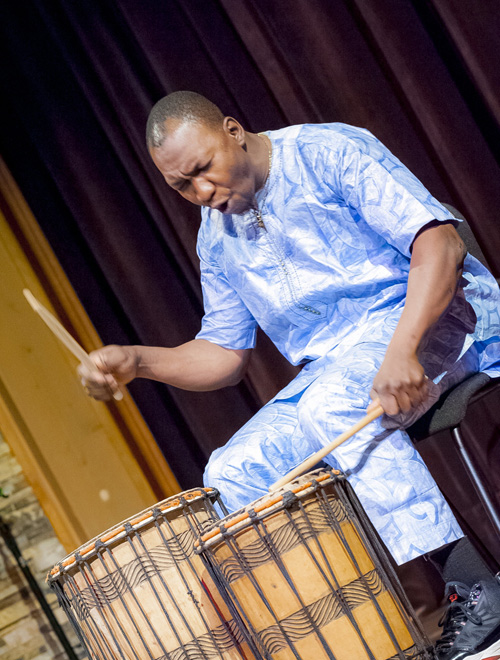
Sidi Mohamed “Joh” Camara grew up in Bamako, Mali surrounded by musicians, praise singers, and story-tellers. He began his formal training with Mouvement Pionnier, and then went on to work with Troupe Sewa and Troupe Districte de Bamako before relocating to the United States in 1996. He has experienced West African dances in their purest traditional form, where a particular dance is unique to that village and the movements have remained unchanged for centuries. Though West African dance companies in urban centers keep the traditions alive, often the context and meaning in which these village dances originated gets lost. “Once they are performed by dance companies in the cities, they are taken out of context. . . As a ballet, it is no longer a part of the ceremony it accompanies.”
Joh’s research has taken him all over Mali to see the dances in the ceremonies of which they are a part. He and his young son Tiemoko were awarded a 2017 MCC Traditional Arts Apprenticeship They focused on the learning of four dances (Didadi, Korodjuga, Mandiani, and Madan), the songs that accompany these dances, as well as why and in what context they are danced. Father and son will also take part in ceremonies within the Malian and Guinean diaspora community both here and in New York.
FINALISTS:
Geoffrey Kostecki, liturgical painting

Geoffrey Kostecki excels at the sacred art known as liturgical painting. As a young man, he was inspired by the powerful imagery of Catholicism, first created for the Church during the Renaissance. Kostecki moved to Italy to study at University Lorenzo Di Medici in Florence. There he gained advanced painting techniques required for liturgical painting which include site-specific design, fresco painting, figurative sculpting, stencil design, gilding, and marbleizing.
After returning home and earning an MFA, Kostecki apprenticed under figurative painter Graydon Parrish, who himslef had trained through the Atelier method, and with trumpe-l’oeil painter Robert Bock.
Kostecki’s original work and restorations can be seen in churches throughout Central Massachusetts and upstate New York, including St. Paul’s Church in West Warren, St. John’s in Worcester, and the 30 x 40 feet nave mural depicted here, commissioned by St. Agnes Church in Lake Placid, NY.
Fabian Gallon, Colombian tiple player

Fabian Gallon grew up in Pereira, the mountainous coffee region of Colombia, where he learned to play the tiple from his father and brothers. He went on to study with Maestro Benjamin Cardona before entering the conservatory of Universidad Technologica of Pereira.
Similar in shape but distinct from the guitar, the 12-stringed tiple is considered the national instrument of Colombia. It recently gained a renaissance when it began to be played more as a solo instrument. The style Gallon developed went from simple strumming to a complex blend of sophisticated picking and rich variations of strumming figures.
Before moving to Boston, Gallon was very active in Bogata’s musical scene, performing and recording with Trio Ancestro, as well as dedicating himself to bringing up the next generation of leading Colombian tiple players. He recently recorded with several Latin American musicians in Boston. He continues a tradition of well-known tiple players like Gonzalo Hernandez, Pacho Benavides, and David Puerta. Eduaro Carrizoa, Orquestra Conductor says, “Colombian tiple has in Fabian Gallon its best passionate and knowledgeable interpreter. In his hands lay the responsibility of keeping the path of the development of the technique and interpretation of the instrument.”
Emerald Rae Forman, Cape Breton & Scottish fiddle player

The distinctive fiddling style of Cape Breton, Nova Scotia has roots in the strathspeys and reels brought to Canada by early 19th century Scottish immigrants. Emerald Rae Forman has mastered both Scottish and Cape Breton fiddling. She began her study with Boston based Barbara McOwen, renowned for her private library of Scottish music books. Emerald went on to compete in the US Scottish Fiddling Championships, winning the US National Champion title at 18 years old. She went on to earn degrees from Berklee College of Music and the University of Glasgow.
Fiddle and dance are closely related; to become a great traditional fiddler, it helps to know the dance steps the fiddle tunes accompany. In 2011, Emerald Rae completed a Mass Cultural Council Traditional Arts Apprenticeship in Irish step dance with Mass Cultural Council Artist Fellow Kieran Jordan. In 2016, she was awarded a Traditional Arts Apprenticeship to mentor Elizabeth Kozachek in Scottish and Cape Breton fiddle playing. Emerald Rae works as a professional performer and teacher of multiple styles of fiddle and step dance. She leads workshop at the Boston Fiddle Club and has served on the Boston Celtic Music Festival
Soumya Rajaram, Bharatanatayam dancer

Soumya Rajaram performs and teaches Bharatanatyam dance, a South Indian classical tradition with strong spiritual connections to Hindu religion and mythology. Although originally a hereditary tradition, the teaching of Bharatanatyam has become institutionalized. Indeed, Soumya came up within a deep lineage of dance teachers trained at the Kalakshetra Foundation in Chennai, India. In addition to her years of dedicated training in the technique and expressive elements of Bharatanatyam, she has extensive training in Carnatic music, which is integral to Bharatanatyam dance.
Known for her exacting standards, Rajaram is skilled in nritta (abstract dance) and abhinaya (emotive aspect). She performs regularly at festivals and concerts and is thought of highly by senior dance teachers who first brought Bharatanatyam to southern New England. Soumya is an active contributor to the India arts community in Greater Boston. She continues to enhance her learning under the mentorship of Sheejith Krishna, spending a few months a year at his studio and home in Chennai.
In studio with Alan Kaufman & local Nepali musicians

A couple of years ago, Alan Kaufman introduced me to Sushil Gautam, a Nepali immigrant he’d met at the local Dunkin Donuts in Arlington. It was Alan’s fiddle case that caught Sushil’s eye and the two struck up a conversation. Sushil, who had written a book on the Nepali sarangi (fiddle), was eager to meet an American fiddler. Today, the two have become friends and Sushil has moved on to work in information technology for a local healthcare company.
Last week, I was delighted that Alan invited me to the filming of In the Tradition, a studio show he writes and hosts at Arlington Community Media, Inc. The hour-long broadcast features local and visiting musicians. Recently, Alan has ventured beyond western traditional music. On the December 20, 2017 shoot, the featured guests were three local Nepali musicians: Shyam Nepali on sarangi, Sushil Gautam on jaw harp and madal, and Ranjan Budhathoki on flutes. Of the three, only one, Shyam Nepali, is a member of the Gandharba occupational caste of musicians. Historically, the Gandharba traveled from town to town in the mountainous regions of Nepal. Much like other hereditary musicians, they played a key role in society, traveling from village to village, spreading news and entertaining.

The tradition of playing the sarangi is associated with the Gandharba. Indeed, Shyam comes from a long line of traditional musicians, primarily sarangi players. His instrument was made by his brother and features a carved bird as a scroll. The sound box is covered with goat skin. Shyam explains that the string is played by placing the fingernail (rather than the pad of the finger) on the metal strings. Although he uses a western style violin bow, traditionally, the bow was made from bamboo strung with soaked cactus fiber instead of horse hair.
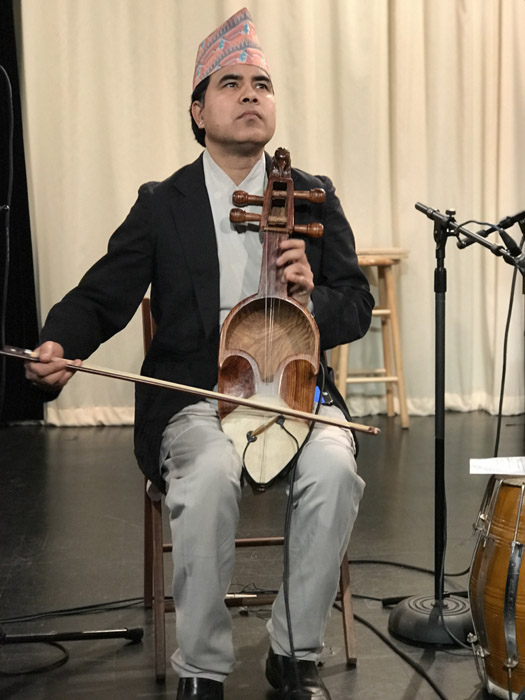
But I’m getting ahead of myself. . .
We all arrived around 6:00 p.m. at Arlington Community Media, Inc., the local cable television station. It being late December, it was already dark and cold. After unloading musical instruments in “Studio A,” everyone gathered downstairs for pizza while Alan went over production notes.
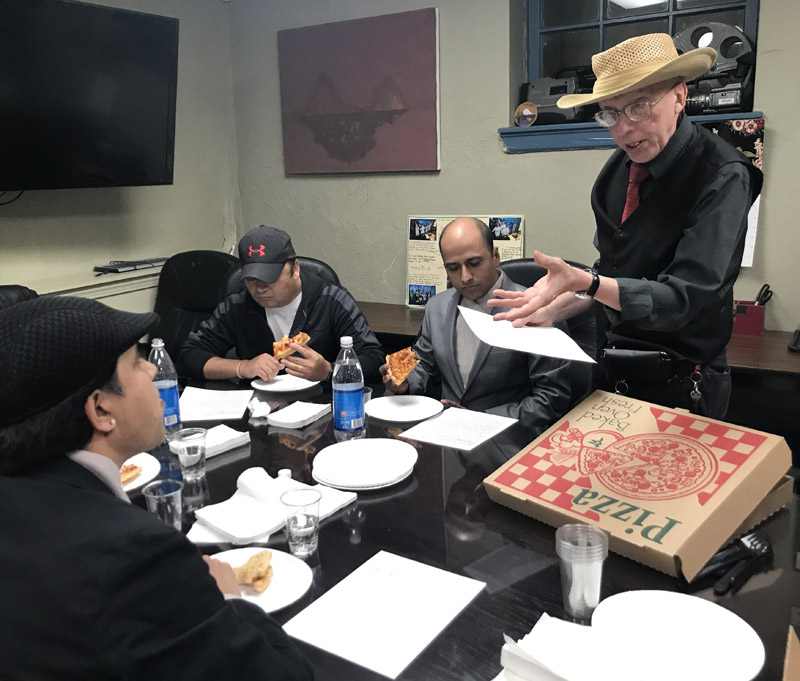
Alan joked with us about how when he picked up the pizza, he mentioned to the take-out staff it was for some Nepali musicians who were going to be performing on his show. “Oh, who?” they responded. Turns out they were from Nepal as well –Greater Boston’s Nepalese version of serial migration.
Once back up in the studio, it was time to tune up the musical instruments, check mic levels, and go over the script.

In addition to the interview-style chat led by Alan, the group performed a number of songs and instrumentals.
Shyam Nepali and Ranjan Budhathoki grew up together in the Kathmandu, Nepal. Ranjan, whose family’s home was farther from the school they both attended, would often go to Shyam’s home. It was a welcoming and musical household. Sushil Gautam grew up 200 kilometers away in Pokhara where he was hypnotized by the music of he Gandharba people. Usually the sarangi is only taught within the occupational caste. However, Sushil’s parents supported him in learning to play the music. It was not common for someone outside the Gandharba commutniy to learn sarangi. He eventually moved to Kathmandu, where he had the luck to rent a house next door to Shyam Nepali.

At the time, he had just started to play the flute, having fashioned one out of small bamboo growing in the back yard. Ranjan went on to become a professional dancer and teacher of dance in Nepal. He and Shyam emigrated to Massachusetts within a few years of each other. When Shyam arrived, the two said, “Why don’t we start a school here? Our population is growing, the children are missing the connection to our Himalayan culture.” Both currently teach at the school they established, the Himalayan Heritage Cultural Academy in Medford, MA.
Shyam spoke of the relationship between the music of Nepal and Southern Appalachia, both being mountainous regions. He recalled first hearing old time and bluegrass music and being blown away by the similarities. Alan and these three Nepali musicians have found common ground, swapping and sharing tunes like the classic, “Cluck Old Hen.”
If you are curious to hear this music live, head over to Chulo Cuisine & Bar, a recently opened Nepalese restaurant located at 5 Spring Street (upstairs) in Watertown Square. They perform Friday, Saturday, and Monday evenings. And be sure to watch for the upcoming Nepali feature on In the Tradition.
Photos & video by Maggie Holtzberg, Folk Arts & Heritage Program, Mass Cultural Council.
Food from Land & Sea: 2017 Lowell Folk Festival

Guest blog by Millie Rahn
Harvest is past and Thanksgiving is upon us, the perfect time to recall recipes and stories, and celebrate the traditions that make us who we are as individuals, families, and communities. We do this in kitchens, at tables, or in other formats where we remember and reflect on the foods we eat, the ways we acquire and prepare them, and the symbols and meanings they have for us, past and present.
As a folklorist, I’m still savoring the bounty of summer’s riches showcased and shared at regional festivals, particularly in Lowell in late July, where I curate and present the foodways demonstrations. The foodways stage at this year’s 31st event was a festive sampling of tastes, cultures, techniques, and stories featuring foods with ties to land or sea.

Foodways complemented the larger folklife area theme of coastal and inland traditions exemplified by tradition bearers who produced items such pottery and baskets used to gather and/or store foods, or the quahog and other shells that are turned into wampum by Wampanoag and Narragansett artists, or ship’s wheels, horse saddles, and blankets for gathering and transporting foods, or temple ornaments used in the blessing of the bounty.
On the makeshift kitchen stage, both home and professional cooks talked about their individual history and culture. Each assembled a recipe while sharing stories of their homelands and the foods they grew up with, and recipes they adapted and maintain here, and then let audiences sample the finished fare—from Lithuanian pickles to Caribbean and Asian poultry and seafood, rounded off with Southwest chili adapted to coastal New England.


Irena Malasauskas emigrated from Lithuania, where her mother always kept wooden barrels of pickles and of sauerkraut in their kitchen. Now Irena makes pickles regularly, keeping them in plastic and glass jars, and even assembled ready-to-eat ones in plastic bags. Pickles, we learned from Irena’s husband and from her granddaughter visiting from Germany, don’t last long in the Malasauskas household.
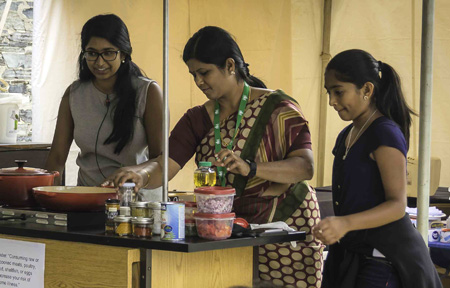
Geetha Raju, originally from Tamil-Nadu in southern India, made a South Indian shrimp curry, ably assisted by her daughters, Shuruthe and Laya, who are learning the family traditions of cooking and baking. While Geetha here uses tinned coconut milk, she noted that at home in India, which she visits as often as she can, they simply can go outside and pick a coconut off a tree. Laya wants to go into the culinary arts; I suspect we’ll be seeing more of her on the Lowell foodways stage.

Gaitskell Cleghorn, Jr., known as “Chef Gates,” teaches culinary arts in an after-school program for middle school students. He and his partner, Mika Brinson, have Jamaican roots. They talked about the variety of fresh ingredients in Jamaica, where chicken is widely available, either in shops or raised in backyards, and the ease of the cooking and eating on the beach or on rafts in the water in a mild climate. They, too, used coconut milk for their chicken dish, while giving tips on slicing vegetables safely and easily, and quizzing the audience on culinary knowledge and the science of cooking.

Han-Ting Lin is a physician from Taiwan where, she says, fish is a staple in markets and “is a must” at New Year’s Eve dinner. As an oncologist and enthusiastic home cook, she advises “everything in moderation” and talked of the benefits and ease of preparing simple, healthy, and inexpensive meals from scratch, especially in a wok. She uses a square-bottomed wok that she brought from Taiwan, but noted similar ones are available in Boston’s Chinatown and can be used on either electric or gas stovetops without an adapter. She shared her favorite fish marinades, which she served on different days with squid and salmon–a commercial Korean barbecue sauce, and her own blend: 1 cup olive oil, a “big ginger root,” and 1 ½ tablespoons bottled curry powder.

Patricia Hazard and her sister Viola Solano, dubbed the “Chili Sisters” onstage, made two kinds of Southwestern chili from their mother’s recipe originally from New Mexico, whence they ordered the special chili pepper ingredients for the Southwest flavor they remember from childhood. One sister likes beans in her chili; the other does not, but the basics are the same and each has been making her chili recipe for decades in coastal New England.
Catch us next year at the 32nd Lowell Folk Festival, when our foodways theme will be FLATBREADS & WRAPPED FOODS. Flatbreads, often called pancakes, can be served “as is” or topped, or wrapped and filled with sweets or savories. Whether you call them ploys, hoe cakes, crepes, blintzes, chapattis, johnnycakes…they’re delicious. Come taste for yourself.
Here’s what happens when . . .
. . . you have the opportunity to hire a professional film crew and still photographer to capture master musicians and dancers performing in a beautiful venue. Videos by Blake Road Productions and stills by Brendan Mercure.

Below are links to each segment of the concert – shot and edited by, Blake Road Productions.
Highlight Reel from Showcase Concert
We are excited to share this highlight reel from our “Hiding in Plain Sight” showcase concert, which took place on Mother’s Day. It captures the talent and energy of some of our state’s most vibrant traditional artists. Shot and edited by Blake Road Productions.
Coming soon will be concert footage of each of the four segments: a Dominican carnival procession by Asociacion Carnavalesca de Massachusetts, South Indian carnatic music and dance, Irish music and dance, and Malian music and dance.
Watch Live webcast of National Heritage Fellows Concert
We are coming up on the last week of September, which means it’s time for the annual feting of our country’s National Heritage Fellows. This year’s fellows include former Massachusett’s resident and Irish fiddler extraordinaire, Seamus Connolly.

The National Council for Traditional Arts and the National Endowment for the Arts produce a spectacular evening performance September 27th at Lisner Auditorium on the George Washington University campus. Fortunately, for those unable to attend the concert, the event will be live streamed at arts.gov, with an archive available following the event. Viewers can share comments and photos on
Twitter using the hashtag #NEAHeritage. You may also request copies of
the concert program by emailing heritage@arts.gov.
Learning Chinese calligraphy from a master
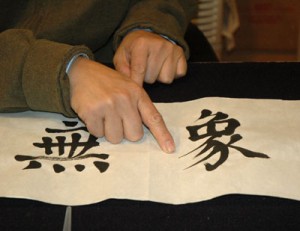
Qianshen Bai is a demanding teacher. Leaning over his apprentice’s brush work, he points out tiny things, “This is the problem. Her problem here is that here, so far so good, and she move this way, see the brush toward this part? The stroke should keep in the same direction. You see? You need to use finger and wrist. . . This kind of work is an illusion. The trick is, where this stroke came from, because calligraphy is art of movement.”
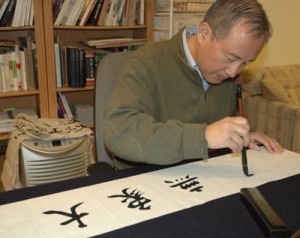
Although there are still quite a few people who practice calligraphy for leisure, very few take the time to study, in depth, the history and various aspects of the art of writing calligraphy. Mei Hung, Executive Director of Chinese Culture Connection, is one of those people. In September 2013, Qianshen Bai and Mei Hung were awarded a Traditional Arts Apprenticeship by the Massachusetts Cultural Council.
In addition to learning the subtleties of the techniques in writing balanced and artistic calligraphy, Mei Hung learned to appreciate a piece of good work with a critical eye. During their 8-month apprenticeship, Mei was introduced to writing couplets, horizontal banners, and, in a smaller font, on fan shaped calligraphy. In addition to learning how to compose the writing in various styles, she completed the composition with date and signature, and the proper way to apply the seal.

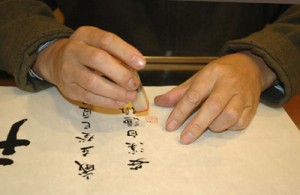
For Mei Hung, having had such a direct experience with master calligrapher Qianshen Bai has been a privilige. “Now I understand that the art of writing calligraphy can be related to playing music, practicing Tai Ji . . .To do it well is a total harmonious relationship among one’s intent, the brush, the ink and the paper. Professor Bai described it this way: the “brush dances and the ink sings.”

This apprenticeship enhanced my knowledge of the art and improved my writing skills, but most importantly, it made me feel humble. It is truly an art that requires a life long practice.” Perhaps, most importantly, Mei mastered a method of how to learn calligraphy by herself in the future.
The next deadline for Traditional Arts Apprenticeship grants is April 2014.
Fried dough, anyone?

Bread may be the staff of life, but fried dough is its treat. Fried dough is often associated with summer fairs and carnivals, where it’s made in vats of hot oil. But this seemingly generic food has roots in many cultures. Varieties of fried dough made in local home kitchens are part of the foodways of cooks with African-American, Greek, Italian, Polish, and Portuguese roots.
Fried breads are made with yeast dough or flour, which is shaped and transformed by frying. Frequently the small, often bite-sized confection is finished off by being rolled in toppings such as honey, sugar, cinnamon, or the sweeteners are sprinkled on top. There’s no such thing as leftovers where fried dough is served!
Come to Foodways Tent this July’s Lowell Folk Festival and you’ll have a chance to see and taste five different versions of fried dough.
COOKING DEMONSTRATIONS:
12:00 p.m. Eleni Zoldi, Greek loukamathes
1:00 p.m. Lucia DiDuca, pizza fritta
2:00 p.m. Natalia Cardosa, Portuguese filhoses & malassadas
3:00 p.m. Lilly Morales, African American hoe cakes and hush puppies
4:00 p.m. Mary Matyka with Helen Dubuc, chrusciki
